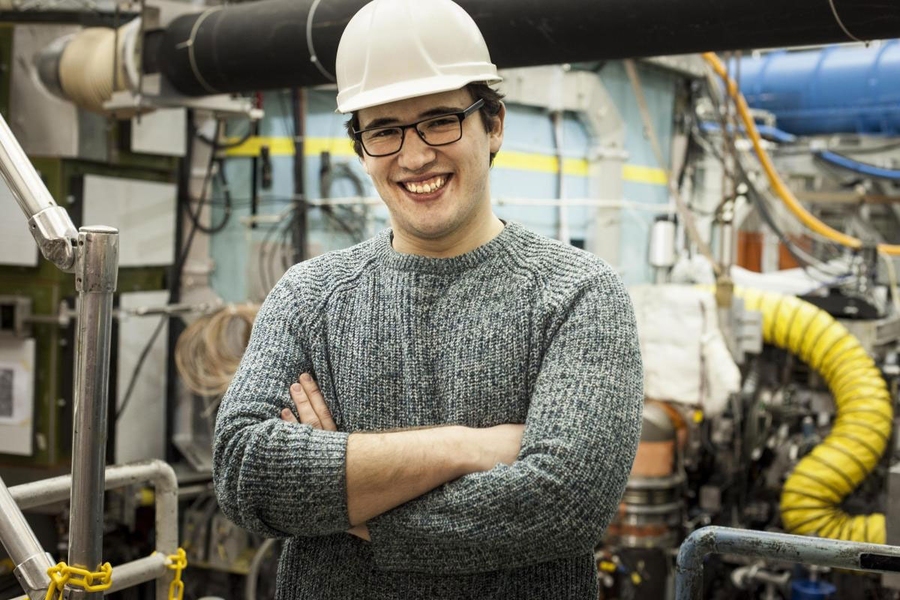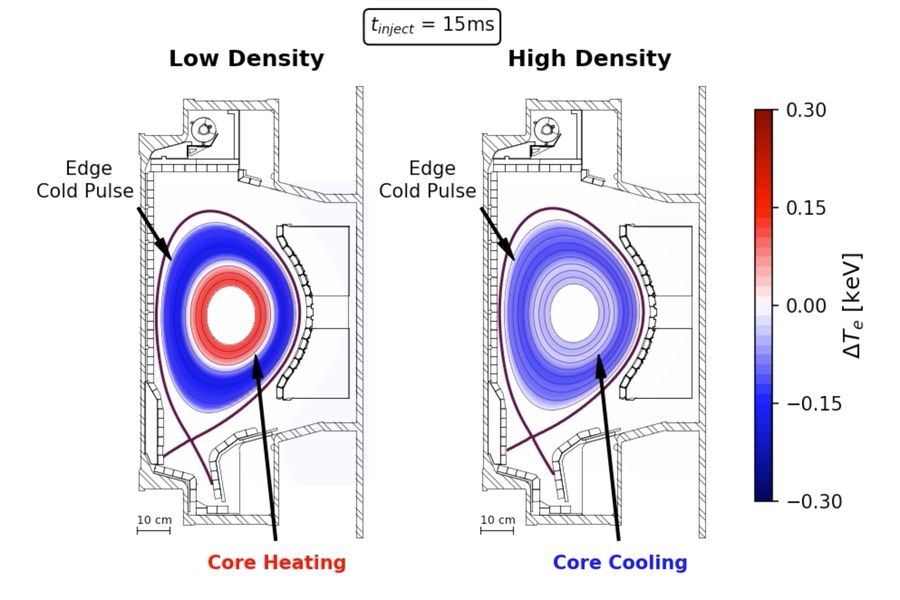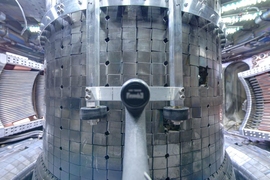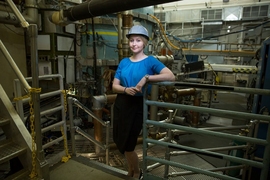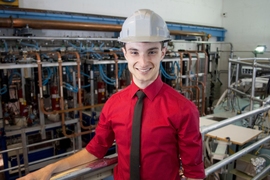To make fusion energy a reality, scientists must harness fusion plasma, a fiery gaseous maelstrom in which radioactive particles react to generate heat for electricity. But the turbulence of fusion plasma can confront researchers with unruly behaviors that confound attempts to make predictions and develop models. In experiments over the past two decades, an especially vexing problem has emerged: In response to deliberate cooling at its edges, fusion plasma inexplicably undergoes abrupt increases in central temperature.
These counterintuitive temperature spikes, which fly against the physics of heat transport models, have not found an explanation — until now.
A team led by Anne White, the Cecil and Ida Green Associate Professor in the Department of Nuclear Science and Engineering, and Pablo Rodriguez Fernandez, a graduate student in the department, has conducted studies that offer a new take on the complex physics of plasma heat transport and point toward more robust models of fusion plasma behavior. The results of their work appear this week in the journal Physical Review Letters. Rodriguez Fernandez is first author on the paper.
In experiments using MIT’s Alcator C-Mod tokamak (a toroidal-shaped device that deploys a magnetic field to contain the star-furnace heat of plasma), the White team focused on the problem of turbulence and its impact on heating and cooling. In tokamaks, heat transport is typically dominated by turbulent movement of plasma, driven by gradients in plasma pressure.
Hot and cold
Scientists have a good grasp of turbulent transport of heat when the plasma is held at steady-state conditions. But when the plasma is intentionally perturbed, standard models of heat transport simply cannot capture plasma’s dynamic response.
In one such case, the cold-pulse experiment, researchers perturb the plasma near its edge by injecting an impurity, which results in a rapid cooling of the edge.
“Now, if I told you we cooled the edge of hot plasma, and I asked you what will happen at the center of the plasma, you would probably say that the center should cool down too,” says White. “But when scientists first did this experiment 20 years ago, they saw that edge cooling led to core heating in low-density plasmas, with the temperature in the core rising, and much faster than any standard transport model would predict.” Further mystifying researchers was the fact that at higher densities, the plasma core would cool down.
Replicated many times, these cold-pulse experiments with their unlikely results defy what is called the standard local model for the turbulent transport of heat and particles in fusion devices. They also represent a major barrier to predictive modeling in high-performance fusion experiments such as ITER, the international nuclear fusion project, and MIT’s own proposed smaller-scale fusion reactor, ARC.
To achieve a new perspective on heat transport during cold-pulse experiments, White’s team developed a unique twist.
“We knew that the plasma rotation, that is, how fast the plasma was spinning in the toroidal direction, would change during these cold-pulse experiments, which complicates the analysis quite a bit,” White notes. This is because the coupling between momentum transport and heat transport in fusion plasmas is still not fully understood,” she explains. “We needed to unambiguously isolate one effect from the other.”
As a first step, the team developed a new experiment that conclusively demonstrated how the cold-pulse phenomena associated with heat transport would occur irrespective of the plasma rotation state. With Rodriguez Fernandez as first author, White’s group reported this key result in the journal Nuclear Fusion in 2017.
A new integrated simulation
From there, a tour de force of modeling was needed to recreate the cold-pulse dynamics seen in the experiments. To tackle the problem, Rodriguez Fernandez built a new framework, called PRIMA, which allowed him to introduce cold-pulses in time-dependent simulations. Using special software that factored in the turbulence, radiation and heat transport physics inside a tokamak, PRIMA could model cold-pulse phenomena consistent with experimental measurements.
“I spent a long time simulating the propagation of cold pulses by only using an increase in radiated power, which is the most intuitive effect of a cold-pulse injection,” Rodriguez Fernandez says.
Because experimental data showed that the electron density increased with every cold pulse injection, Rodriguez Fernandez implemented an analogous effect in his simulations. He observed a very good match in amplitude and time-scales of the core temperature behavior. “That was an ‘aha!’ moment,” he recalls.
Using PRIMA, Rodriguez Fernandez discovered that a competition between types of turbulent modes in the plasma could explain the cold-pulse experiments. These different modes, explains White, compete to become the dominant cause of the heat transport. “Whichever one wins will determine the temperature profile response, and determine whether the center heats up or cools down after the edge cooling,” she says.
By determining the factors behind the center-heating phenomenon (the so-called nonlocal response) in cold-pulse experiments, White’s team has removed a central concern about limitations in the standard, predictive (local) model of plasma behavior. This means, says White, that “we are more confident that the local model can be used to predict plasma behavior in future high performance fusion plasma experiments — and eventually, in reactors.”
"This work is of great significance for validating fundamental assumptions underpinning the standard model of core tokamak turbulence,” says Jonathan Citrin, Integrated Modelling and Transport Group leader at the Dutch Institute for Fundamental Energy Research (DIFFER), who was not involved in the research. “The work also validated the use of reduced models, which can be run without the need for supercomputers, allowing to predict plasma evolution over longer timescales compared to full-physics simulations,” says Citrin. “This was key to deciphering the challenging experimental observations discussed in the paper.”
The work isn’t over for the team. As part of a separate collaboration between MIT and General Atomics, Plasma Science and Fusion Center scientists are installing a new laser ablation system to facilitate cold-pulse experiments at the DIII-D tokamak in San Diego, California, with first data expected soon. Rodriguez Fernandez has used the integrated simulation tool PRIMA to predict the cold-pulse behavior at DIII-D, and he will perform an experimental test of the predictions later this year to complete his PhD research.
The research team included Brian Grierson and Xingqiu Yuan, research scientists at Princeton Plasma Physics Laboratory; Gary Staebler, research scientist at General Atomics; Martin Greenwald, Nathan Howard, Amanda Hubbard, Jerry Hughes, Jim Irby and John Rice, research scientists from the MIT Plasma Science and Fusion Center; and MIT grad students Norman Cao, Alex Creely, and Francesco Sciortino. The work was supported by the US DOE Fusion Energy Sciences.
